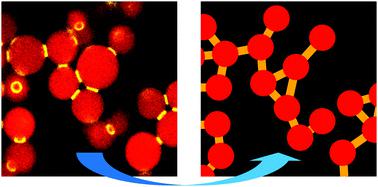当前位置:
X-MOL 学术
›
Soft Matter
›
论文详情
Our official English website, www.x-mol.net, welcomes your
feedback! (Note: you will need to create a separate account there.)
Connecting particle clustering and rheology in attractive particle networks.
Soft Matter ( IF 2.9 ) Pub Date : 2020-08-11 , DOI: 10.1039/d0sm00861c Sebastian Bindgen 1 , Frank Bossler 1 , Jens Allard 1 , Erin Koos 1
Soft Matter ( IF 2.9 ) Pub Date : 2020-08-11 , DOI: 10.1039/d0sm00861c Sebastian Bindgen 1 , Frank Bossler 1 , Jens Allard 1 , Erin Koos 1
Affiliation

|
The structural properties of suspensions and other multiphase systems are vital to overall processability, functionality and acceptance among consumers. Therefore, it is crucial to understand the intrinsic connection between the microstructure of a material and the resulting rheological properties. Here, we demonstrate how the transitions in the microstructural conformations can be quantified and correlated to rheological measurements. We find semi-local parameters from graph theory, the mathematical study of networks, to be useful in linking structure and rheology. Our results, using capillary suspensions as a model system, show that the use of the clustering coefficient, in combination with the coordination number, is able to capture not only the agglomeration of particles, but also measures the formation of groups. These phenomena are tightly connected to the rheological properties. The present sparse networks cannot be described by established techniques such as betweenness centrality.
中文翻译:

在有吸引力的粒子网络中连接粒子聚类和流变学。
悬浮液和其他多相系统的结构特性对于整体加工性能,功能和消费者接受度至关重要。因此,了解材料的微观结构与所得流变性能之间的内在联系至关重要。在这里,我们演示了如何量化微观结构构象中的转变并将其与流变学测量相关联。我们从图论,网络数学研究中发现半局部参数,对连接结构和流变学很有用。我们使用毛细管悬浮液作为模型系统的结果表明,将聚集系数与配位数结合使用,不仅可以捕获颗粒的团聚,还可以测量团的形成。这些现象与流变性密切相关。当前的稀疏网络无法通过诸如中间性中心性之类的既定技术来描述。
更新日期:2020-09-23
中文翻译:

在有吸引力的粒子网络中连接粒子聚类和流变学。
悬浮液和其他多相系统的结构特性对于整体加工性能,功能和消费者接受度至关重要。因此,了解材料的微观结构与所得流变性能之间的内在联系至关重要。在这里,我们演示了如何量化微观结构构象中的转变并将其与流变学测量相关联。我们从图论,网络数学研究中发现半局部参数,对连接结构和流变学很有用。我们使用毛细管悬浮液作为模型系统的结果表明,将聚集系数与配位数结合使用,不仅可以捕获颗粒的团聚,还可以测量团的形成。这些现象与流变性密切相关。当前的稀疏网络无法通过诸如中间性中心性之类的既定技术来描述。











































 京公网安备 11010802027423号
京公网安备 11010802027423号